How To Go Hiking With a Fly Rod
April 28th, 2022
You’re reading this because you want to bring your fly rod hiking into remote areas, but you don’t want to break it. Fortunately, I’ve got several solutions for you, any of which will work.
Yes, I’ve broken a fly rod before–my Winston 7.5-foot 3-weight, a favorite of mine for small streams and creeks. And yes, I cringed when it snapped.
While it’s true that most rod companies have relatively generous programs to fix broken fly rods, the wait time can vary from several weeks to several months, and there’s always a fee involved (usually around $75).
Some of the below solutions are intuitive, and some aren’t, but you’ll soon know all the options for safely transporting your fly rod through the backcountry.
Here I am after a long trek into remote wilderness for some fly fishing. This river had both rainbow trout and brown trout.
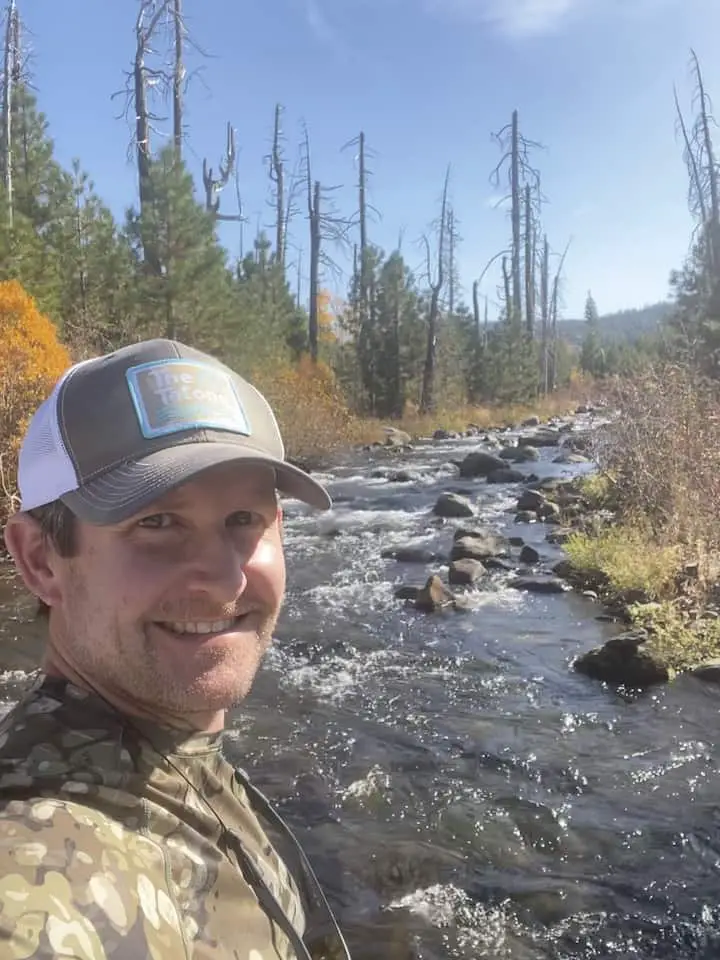
How to go Hiking with a Fly Rod
When you’re hiking into remote wilderness, you can secure your fly rod a few different ways. Below you can read my tips, in no particular order of importance. It really comes down to personal preference at the end of the day.
Some options are virtually free, some are a little more expensive, and others just take time and effort.
Strap the rod to your backpack or slingpack
This is the most popular option if your fly rod came with a rod tube. Rod tubes are long, rigid cylinders with a screw-on top. A light car could probably drive over one and not break the rod inside.
Just tie or strap your fly rod tube to the outside of your backpack or slingpack. It’s usually a little easier with a backpack since slingpacks are always at an angle, but it can be done with either.
Personally, I use 4-inch zip ties to attach my fly rod to my backpack. Zip ties are incredibly secure, strong, and inexpensive. Once zip-tie your rod, it’s not going anywhere! The zip ties can go through zipper holes, fabric loops, you name it.
If you have a drink holder on your pack, slip the bottom of the rod tube into it and then strap-on the top.
Get creative.
As you can see, fly rod tubes are relatively long (and fortunately ultralight), but they’re still very packable.
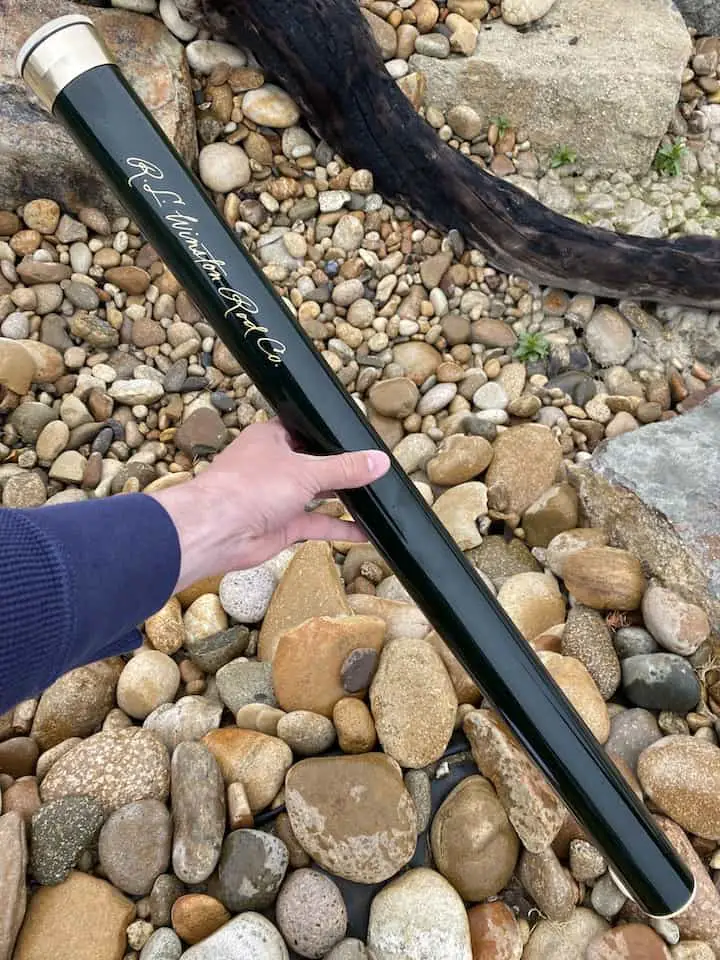
DIY Fly Rod Tube Cases
In case your rod didn’t come with a rod tube, or if you lost it, just do a search on YouTube for “diy fly rod tubes” or “diy fly rod cases” and you’ll find a bunch of instructional videos.
Alternatively, rod companies almost always sell replacement rod tubes.
Another option is to buy some polyethylene shipping tubes with a wall thickness of 0.04″. These water-safe tubes can be cut to the exact length you need, can fit any rod, and are super light. They also come with plugs for the top and bottom.
Carry it fully assembled
It might sound risky, but honestly, I often hike through the woods with my rod fully assembled. I’ve never had an issue.
Everyone has an opinion. Some say you need to carry your rod backwards and it won’t snag on anything (which I can attest is absolutely not true).
Others say carry it tip-forward and guide your rod as you walk.
I’ve tried both methods, and I prefer tip-forward, especially through brush. I like to see my rod in front of me so I can guide it through openings in the brush.
Rod Sock
This isn’t a favorite method of mine, but I know people who’ll just put their disassembled fly rod into the rod sock and attach it to their pack if they’re only hiking a short distance, say a quarter-mile or less.
A rod sock is the fabric sleeve that you put the sections of your fly rod into before you insert them into the rod tube. They’re usually made of tough fabric that can take a beating.
Here’s a picture of me when I was doing some fly fishing in remote backcountry pocket water. I caught a small brown trout just a couple minutes after this picture was taken.
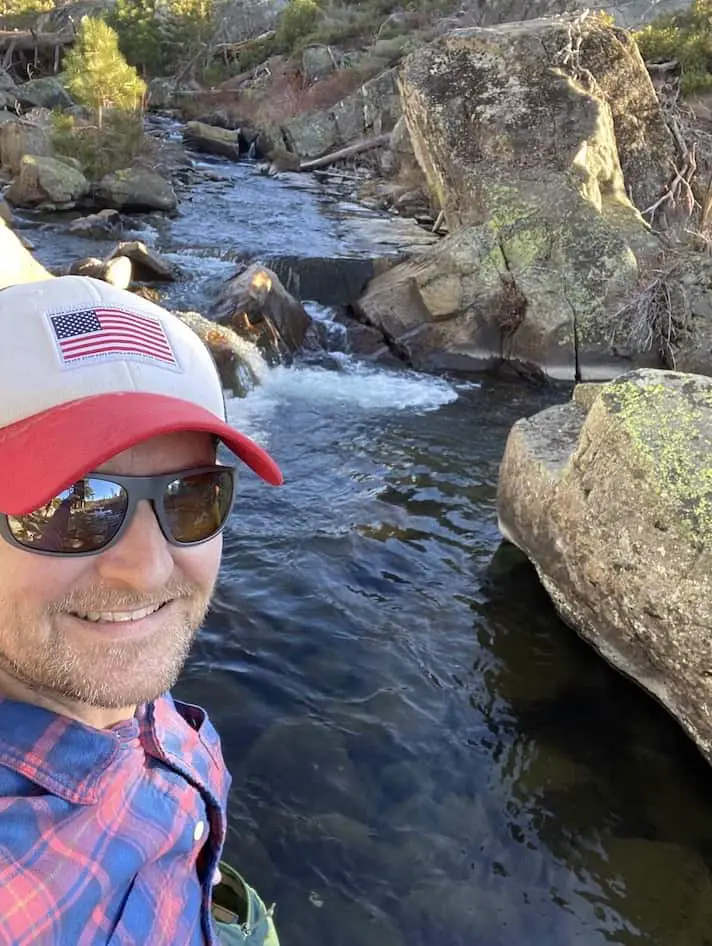
Hiking Fly Rod Considerations
Most fly rods are 7.5 to 10 feet, and are comprised of three or four pieces. But, here are some options you might now have considered. If you’re into hiking, you should be aware of these products.
5-7 Piece Fly Rods
Yes, you can buy 5-7 piece fly rods.
The obvious advantage is that they can be fully disassembled and packed into a tube or sock just 16-inches in length. You could pack one of these rods inside your pack.
Tenkara Fly Rods for Backpacking
Tenkara rods are nothing if not convenient.
If you’re not familiar with a Tenkara rod, think of it as a collapsible “cane pole” fly rod with line attached to the end of the rod tip. There’s no reel.
These compact rods make it really easy to fish small, narrow creeks and streams where fly casting would be a rat’s nest of tangles and snags.
You can buy them in lengths of up to 10-feet, but they collapse neatly into themselves down to a total length of around 16-inches.
Here’s a picture of my favorite Tenkara rod. The round ring is just for line and fly storage–it’s removed when you fish.
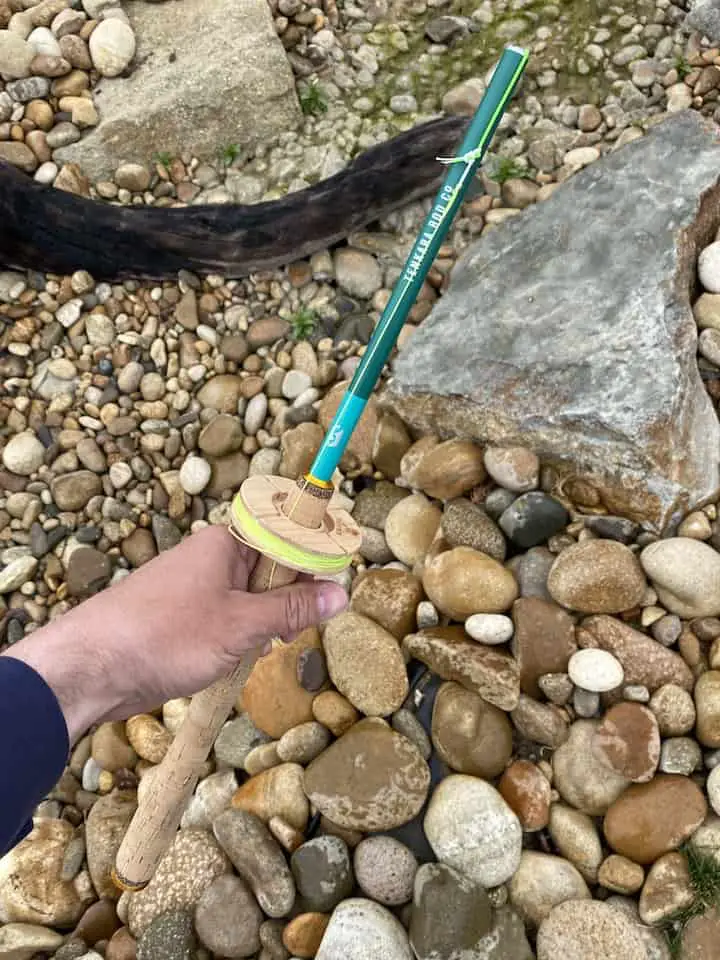
Do Fly Rods Break Easily?
Fly rods can break easily because they’re both hollow and made of graphite. Graphite is a form of carbon and while strong, it will only flex to a certain degree before it snaps like a dry twig. Even heavy streamer patterns can break your fly rod if there’s a collision while casting.
Most incidents of fly rods breaking are from car doors and trunks being closed with the rod exposed or not fully packed.
How to Carry a Fly Rod in a Car?
You have several choices when it comes to transporting your fly rod in a vehicle including rod mounts on the top or hood of your car, fully assembled in the cabin, or in a rod tube for assembly on the water.
Vehicle Rod Mounts
I see two general veresions of vehicle rod mounts.
The first is a contraption that is affixed to your vehicle’s hood that secures the reel section, with the rest of the rod pointing up and over the car’s roof where it is also secured. I find this option strange because your reel, rod, and fly line are not only exposed to the sun and rain, but also to rocks, pebbles, and sand that are kicked-up while driving behind other vehicles.
The second option is a fully enclosed horizontal rod mount on the roof of the vehicle. This is a much safer option because it’ll protect your rod from the elements. But, I still struggle to see the value.
They’re expensive and seem like a solution looking for a problem. I think it’s more about advertising that you’re a fly angler. But, I could be wrong.
Fully Assembled in the Cabin
The option I opt for 95% of the time is to travel with my rod fully assembled inside my vehicle. I understand if this isn’t an option for some folks who drive smaller cars, but it sure is convenient.
I insert the rod from the rear hatch and lay the tip on the dashboard. If the rod tip bounces while I drive, I put a cloth underneath it.
Rod Tube Storage
This is the option I choose when I’m going to be driving for hours to a fishing destination and I have more things to pack.
In this case, I’d rather just keep my rod in its tube to prevent breakage. Assembling your rod and stringing the fly line through the guides takes about three minutes from start to finish, so it’s not exactly a big deal.
Backcountry Fishing Nets
You can buy ultralight collapsible fishing nets that are very packable, taking up very little room in your gear.
Another option is to just bring the net you usually fish with, but in my experience this is a huge hassle.
My usual net, which is wooden, fits neatly in my fly fishing backpack. But a single branch can snag it and silently pull it right out. This has happened to me many times.
I actually lost two nets this way, until I attached a cord.
Summary
When I go hiking into the mountains, my fly rod is an essential part of my backpacking gear. Who am I kidding–other than food it’s the most important part of my gear.
Since much of backcountry angling seems to take place in boulder-strewn streams and rivers, don’t miss my article on how to fly fish pocket water. Also, I wrote an article about the best fly fishing slingpack I’ve ever used.
If you use the above tips I’ve provided, you’ll spend your time focused on watching for mountain lions and poison oak rather than worrying about breaking your rod.
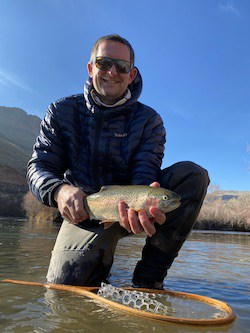
About the Author
My name's Sam and I'm a fly fishing enthusiast just like you. I get out onto the water 80+ times each year, whether it's blazing hot or snow is falling. I enjoy chasing everything from brown trout to snook, and exploring new waters is something I savor. My goal is to discover something new each time I hit the water. Along those lines, I record everything I learn in my fly fishing journal so I can share it with you.
Follow me on Instagram , YouTube, and Facebook to see pictures and videos of my catches and other fishing adventures!


